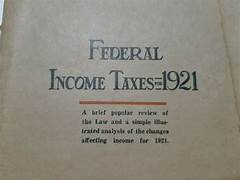On October 24, 1921, the United States experienced a significant change in its tax policy as new lower taxes were implemented. This policy shift aimed to stimulate economic growth, encourage investment, and provide relief to taxpayers during a period of post-war recovery. In the aftermath of World War I, the U.S. economy faced challenges such as high inflation and a slowdown in economic activity. In response, policymakers sought ways to boost economic growth and provide relief to both individuals and businesses. Lowering taxes was seen as a crucial step in achieving these objectives. The new tax policy aimed to reduce the burden on individuals and corporations by lowering tax rates and providing various tax incentives. It was believed that lower taxes would incentivize spending, investment, and job creation, thereby stimulating economic activity and promoting recovery. One of the key aspects of the new tax policy was the reduction in income tax rates. The top marginal tax rate was lowered from 73% to 58%, providing significant relief to high-income individuals. This reduction allowed individuals to keep more of their earnings, which in turn increased disposable income and potentially boosted consumer spending. In addition to income tax rate reductions, the new tax policy also introduced various tax incentives for businesses. This included accelerated depreciation allowances, which allowed businesses to deduct the cost of capital investments more quickly. The goal was to encourage businesses to invest in new equipment, machinery, and infrastructure, thereby stimulating economic growth and job creation. The implementation of lower taxes had both short-term and long-term effects on the U.S. economy. In the short term, the policy provided immediate relief to individuals and businesses, boosting consumer spending and investment. It also helped to restore confidence and optimism in the economy, which was vital for recovery after the war. In the long term, the lower taxes policy contributed to sustained economic growth. By reducing the tax burden on individuals and businesses, it provided the necessary incentives for increased investment and entrepreneurship. This, in turn, led to job creation, higher productivity, and increased economic output. However, it is important to note that the impact of lower taxes is not without controversy. Critics argue that reducing tax rates primarily benefits the wealthy and exacerbates income inequality. They argue that tax cuts should be targeted towards low-income individuals and families who are most in need of relief. Furthermore, the success of lower taxes in stimulating economic growth depends on various factors, such as the overall economic climate, government spending policies, and the effectiveness of other economic measures. Lower taxes alone may not guarantee economic prosperity and must be complemented by sound fiscal and monetary policies.
24 Oct, 1921 U.S.A. New Lower Taxes
